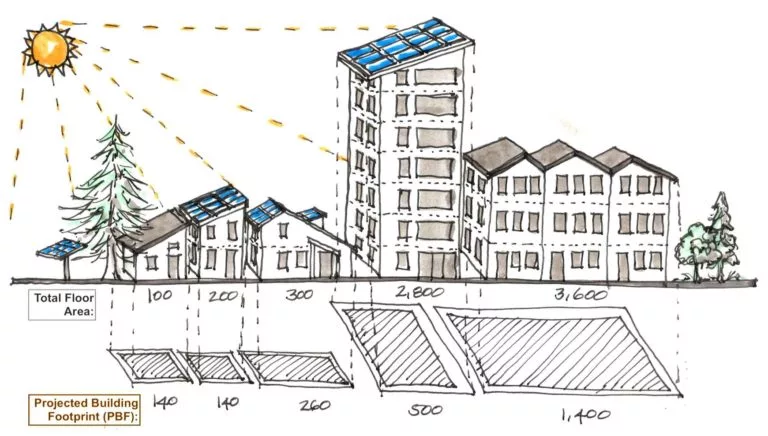
There seems to be a proliferation of standards that discuss the use of energy in a building. The building can be ‘net’, ‘nearly’ or ‘plus’ Zero Energy. The way that these definitions are used can be very arbitrary. The principle that needs to be applied is to aim for an all-renewable future. In many cases all that is done is to bolt on enough renewables to be able to balance out consumption, and then you get to claim that you have met a particular target.
Unfortunately, this does not address the level of energy consumption and how it can be reduced. In order to future-proof our buildings, the Passivhaus Institute (PHI) has introduced a new system for the equitable assessment of energy use. By applying these principles we can aim for a 100% renewable energy future.
Technology in renewables has come a long way and there have been significant improvements in efficiencies and reduction in costs. These improvements have been acknowledged by the PHI along with the recognition that fossil fuels and non-renewable forms of energy need to be phased out. The PHI has introduced the two new classes, Premium and Plus, to incentivize the use of renewable energy in buildings.

The new classes now calculate Primary Energy by applying Primary Energy Renewable (PER) factors that acts as a penalty system. Not only are they designed to encourage the use of renewable energy, they also encourage the use of equipment in buildings that will increase the efficient delivery of that energy. The PER factor that is applied will vary depending on the location. So if we look at the energy required for domestic hot water in Adelaide you will get a number of PER factors depending on how it is generated. For electric heat pump 1.25, natural gas 1.75, heating oil 2.3.
The PER factors not only depend on the type of fuel used, but also on a variety of site specific conditions including the time of year that the energy is generated and required. Site-specific load profiles are calculated on an hourly basis. This allows for variations in utility grids and for typical time-of-day use profiles to be factored in. The availability of renewable energy can also vary depending on local factors and these also need to be factored into the calculations. For example, Adelaide PER factors for heat pumps for hot water/ cooling/ heating are 1.25/1.35/1.75. These corresponding figures for Melbourne are 1.25/1.0/1.5, while for Perth are 1.2/1.05/1.8.
While some of this power will be able to be used as it is being generated. Any surplus will need to be stored. The PHI model allows for short and long term methods of storage. In all these methods there will be storage losses that need to be taken into consideration. On top of this there are also transmission losses depending on where the electricity is generated. Renewable energy generated on site and used immediately has a PER factor of 1.0. Fossil fuel use is discouraged in the new system and is given a high PER factor. Once the final overall PER factor is determined the actual Primary Energy demand (PE) is multiplied by the PER factor to determine the PER demand. On top of this there will need to be a minimum amount of renewable energy generated on site. To achieve certification in one of the new classes the PER demand and renewable energy generated will need under and over the figures set out in the Passivhaus (PHPP) software.

Most net zero type calculations relating to the amount of energy consumed and renewable energy generated only look at the difference between the two. These calculations will reward single storey buildings on large sites and penalize taller buildings which typically are on small sites relative to total floor area.
In order to future-proof our buildings, the PHI has developed a new system which also allows for the evaluation of renewable energy. The building is evaluated in the context of a 100% renewable energy future. These sources of primary energy come from wind, solar and hydroelectricity. To create some balance in the calculation the Passivhouse institute recognizes that all sites are not equal and uses the following principles:
-Renewable offsets are calculated based on the Projected building footprint (PBF) rather than total floor area. This means that multi-storey buildings are able to achieve Premium and Plus standards.
-Buildings with no solar access are able to purchase off-site renewable energy facilities.
-PH Classic buildings with no renewable energy supply are still optimized for efficiency first in anticipation of a future grid supply of all renewable energy.
On a final note, while biofuels are considered a renewable energy source, they carry a penalty for replacing food production. Their burning also generates particulate matter that is both unhealthy and emits carbon. For these reasons, the use of biofuels is allowed, but has been capped to limit its use.
Every inch of our homes are not only beautifully designed, they are calculated and built to surpass the World’s most rigorous energy efficiency, comfort and sustainability standards for buildings. Every component, every wall, window and even appliance is taken into consideration when meeting the Passivhaus performance standards
available from 9:00 – 18:00
Address: 21 Beatty St, Flinders Park, South Australia
© Copyright 2023 – All rights reserved